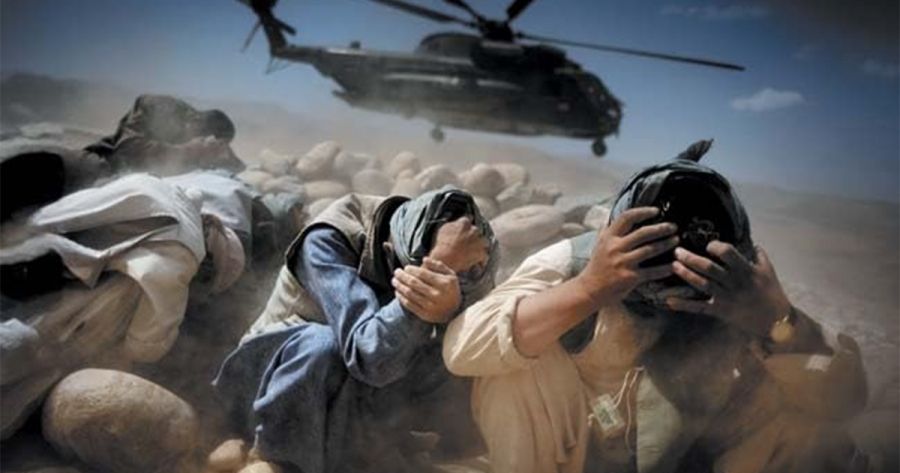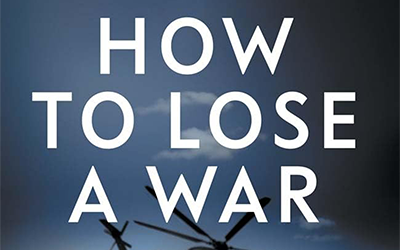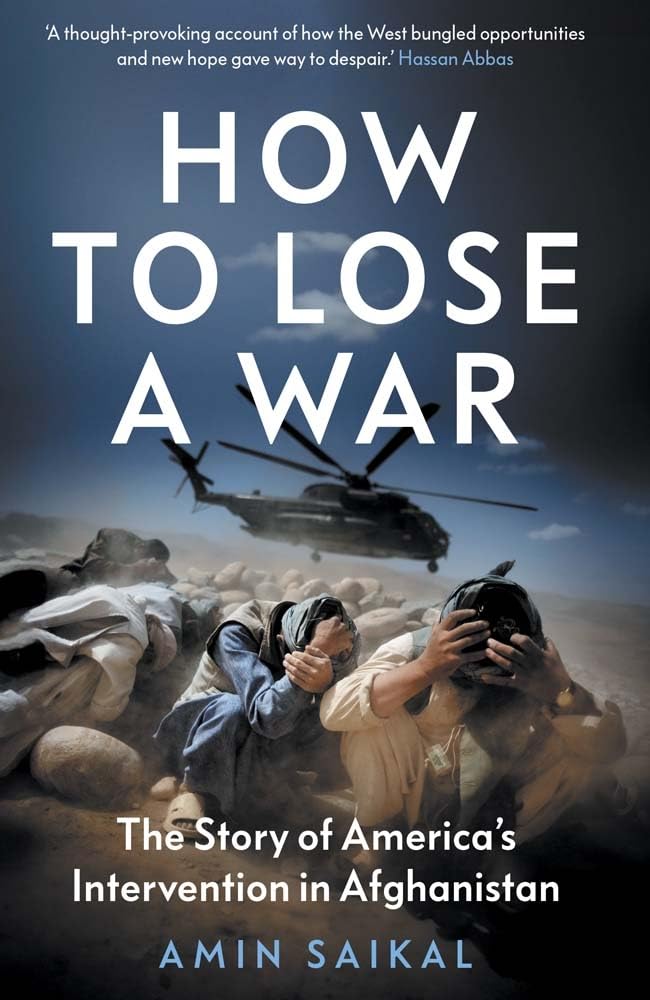
- Free Article: No
- Contents Category: United States
- Review Article: Yes
- Article Title: System failure
- Article Subtitle: What the invasion of Afghanistan revealed
- Online Only: No
- Custom Highlight Text:
Though scarcely a teenager at the time, I remember clearly what I was doing when I heard the news of John F. Kennedy’s assassination in 1963. That was a seminal event for the baby-boomer generation – not only in the United States, but around a then barely globalised world. I suspect the equivalent event for young adults today is the horrifying television footage, rebroadcast countless times since, of two passenger aircraft being deliberately flown into the twin towers of New York’s World Trade Center on 11 September 2001.
- Featured Image (400px * 250px):

- Alt Tag (Featured Image): Ian Parmeter reviews ‘How to Lose a War: The story of America’s intervention in Afghanistan’ by Amin Saikal
- Book 1 Title: How to Lose a War
- Book 1 Subtitle: The story of America’s intervention in Afghanistan
- Book 1 Biblio: Yale University Press, US$30 hb, 318 pp
- Book 1 Cover Small (400 x 600):

- Book 1 Cover (800 x 1200):

To fully appreciate the extraordinary shock the 9/11 terrorist attacks generated around the world, one needs to recall the extent to which the United States in the immediate post-Cold War era stood alone at the pinnacle of world power. Russia, though possessing a formidable nuclear arsenal, was hamstrung by post-Soviet economic chaos. China, though also a nuclear state, albeit with far fewer warheads than the United States and Russia, was still in its ‘hide and bide’ phase (former leader Deng Xiaoping’s maxim that China, in its dealings with the world, should hide its capacities and bide its time).
US statesman Henry Kissinger, at the time a one-man brains trust for the Republican Party, had just published a book titled Does America Need a Foreign Policy? (2001). His answer was yes, and he wanted his book to serve as a starting point for debate on ways in which the United States could leverage its new status to achieve a number of foreign policy goals that had eluded it in the twentieth century. But senior personnel in the Bush administration had no time for Kissingerian subtleties and were openly hubristic. New York Times journalist Ron Suskind, in a 2004 article entitled ‘Faith, Certainty and the Presidency of George W. Bush’, quoted a prominent administration official (believed to be Bush’s Senior Advisor, Karl Rove) as saying, ‘We’re an empire now, and when we act, we create our own reality.’
In his latest book, Amin Saikal, Emeritus Professor of Middle Eastern and Central Asian Studies at the Australian National University, tells the story of how America’s intervention in Afghanistan became the longest war in US history. He explains why the mightiest military power on the planet failed to defeat a puny opponent: the Taliban, a Sunni Islamist nationalist movement comprising mainly Pashtuns, the largest ethnic grouping in Afghanistan and about half the country’s population. In a short book with 229 pages of text (though with an additional thirty-seven pages of detailed notes) divided into eight crisply written chapters, Saikal sets out clearly the mistakes of planning, strategy, and execution that doomed the US project almost from the start and allowed the Taliban to return to power, scarcely changed from the dictatorship the United States had ousted almost twenty years before.
At the start of the book, Saikal acknowledges that these US failures have received comprehensive examination since the chaotic withdrawal of American troops from Kabul in August 2021. What new information or insight does he bring to the debate? Saikal says in a preface that he was motivated by growing concerns that, despite the large volume of work that has been published on Afghanistan, some critical gaps remained in the literature. He therefore passes relatively lightly over matters which previous studies of the war have dealt with in detail: the country’s complex history, the ideology and modus operandi of the Taliban, and the spoiler role of Pakistan and other regional actors.
Rather, he draws on eyewitness accounts which, he says, have not previously been made public, of several Afghan and American insiders. In particular, he accesses the frank views of his brother, former Afghan deputy foreign minister Mahmoud Saikal, and retired US Army lieutenant-general and former US ambassador to Afghanistan Karl Eikenberry. In the book, Saikal reports the comments of both to help illuminate the dysfunctional governance under President Hamid Kazai from 2002 to 2014 and the increasing decay of the subsequent National Unity Government, when Ashraf Ghani as president shared power with his rival, Abdullah Abdullah, in a specially created post of Chief Executive – a recipe for policy deadlock.
Saikal explores various options short of war available to the United States in responding to 9/11. None of these would have satisfied the Bush administration’s need for demonstrable retaliation, fuelled by the public’s anger: the humiliation of the Al Qaeda attack had to be avenged. Though the invasion was planned in haste, the United States had two intertwined objectives. One was specifically to punish the perpetrators of 9/11 – Al Qaeda and its leader, bin Laden – and their protectors, the Taliban, thus ensuring that Afghanistan was no longer a breeding ground for terrorist groups. The second was to achieve this in conjunction with the administration’s wider foreign policy goals of democracy promotion and what it termed a ‘global war on terrorism’ (an early Bush description of the latter as a ‘crusade against terrorism’ was quickly discarded, given the obvious ‘clash of civilisations’ overtones).
Saikal explains why the administration’s planning for a brief ‘light footprint’ campaign (a small number of troops in and out of the capital, Kabul, to capture bin Laden and remove the Taliban) evolved into an open-ended ‘heavy footprint’ operation spread around the entire country (at its peak 130,000 mainly NATO troops from forty-two countries, including Australia, under the rubric of the International Security Assistance Force – or ISAF).
The first reason was the failure to capture or kill bin Laden during the initial intervention, leading to an obsession with finding him. The mission could not be judged a success while he remained at large. The second was the US invasion of Iraq in 2003 before the goals of the Afghan campaign had been achieved. The Iraq war soon became the main battleground, relegating Afghanistan to secondary importance. A third reason was expansion of the original war aims to include modernising a traditional patriarchal, multi-ethnic, and transactional (i.e. corrupt) society – clearly a huge undertaking and arguably impossible for an outside power to achieve.
On taking office in 2009, President Barack Obama saw that he had inherited a mess in Afghanistan and Iraq. He wanted out of both. Though he was able to wind down the Iraq war, with the last US troops leaving in December 2011, quitting Afghanistan was more complex. The killing of bin Laden in Pakistan in 2011 opened the way. Saikal describes how Obama then reset US strategy to move from counter-terrorism and counter-insurgency to ‘Afghanising’ the war: training the Afghan armed forces to manage security. At the same time, Obama set the end of 2014 for withdrawal of most of the US and allied troops, changing America’s approach from a conditions-based to a time-bound involvement. That signalled to the Taliban that an end to the Western military presence was in sight. Although the United States held on for another seven years, eventual Taliban victory was never in doubt.
Saikal argues that the failure in Afghanistan has emboldened America’s main adversaries – Russia, China and Iran. It may have been a factor in Russian President Vladimir Putin’s decision to invade Ukraine, and in China’s Xi Jinping becoming more assertive in challenging the United States over its support of Taiwan and opposition to Chinese expansion in the South China Sea. Saikal detects also that Washington’s Arab allies, especially in the Persian Gulf, have felt compelled to question the reliability of the United States as their traditional security provider.
Professor Saikal is undoubtedly Australia’s foremost expert on Afghanistan, and he ranks among the best in the world in this field of study. Accessible and of interest to both the expert and general reader, this important book provides a fresh and illuminating look at one of this century’s major conflicts. One reason it should be read is that it would be unwise for Western governments to assume that, with our military involvement there now over, Afghanistan can be safely ignored. Quoting a June 2023 UN Security Council report, Saikal warns that the country is again at serious risk of becoming a terrorist nest under the Taliban – as it was in 2001.


Comments powered by CComment